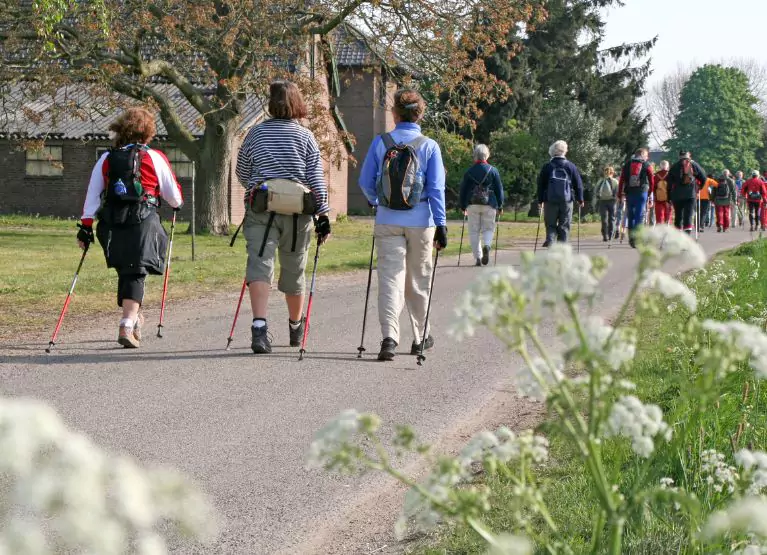What is Nordic Walking?

Key Takeways
Have you ever noticed people speeding around town with walking poles and looking like they’re getting a great workout? If so, you might have crossed paths with Nordic walkers!
And if you hadn't heard of it before clicking on this article, you’re probably wondering what it’s all about. Nordic walking is a full-body workout in which special lightweight poles are held in each hand to activate the entire body while walking.
Nordic walking poles resemble ski poles, and that’s because the sport of Nordic walking originated from cross-country skiers in Finland who used this technique as a form of training in their off-season.
But is Nordic walking that much different from regular walking? What unique health benefits does it have, if any? Let’s take a look at the benefits of Nordic walking and how you can get started with this activity.
Health Benefits of Nordic Walking

Walking is one of the most effective, safe, and accessible ways to stay active, especially for individuals who may have a more challenging time with high-impact sports and activities.
Regular exercise has been proven to have benefits such as a reduced risk of premature death and chronic diseases and can even increase your quality of life. Nordic walking is a great way to get your entire body moving and is a great place to start when working on getting your fitness levels up.
If you’ve never tried Nordic walking, you may be hesitant to invest in the equipment it involves before understanding the benefits and potential risks. Here are some of the best reasons to take up Nordic walking.
It's a Low Impact Activity
Compared to high-impact physical activities like basketball or tennis, which may involve lots of jumping and running, Nordic walking is a low-impact sport that puts less stress on the body.
For beginners or anyone working on getting back in shape, a sport like Nordic walking can significantly increase endurance and stamina without worrying about injury.
Nordic walking has also been linked to increased mobility in individuals with pulmonary conditions and Parkinson’s disease. Because of its low-impact nature, this sport is safer for older individuals, anyone with arthritis, or people who may be prone to injury.
It's a Full-Body Movement

The unique Nordic walking technique engages the entire body. When walking with Nordic poles, the arms move back and forth while forcefully planting the poles on the ground between strides to propel you forward with each step.
As several muscle groups are involved when you practice Nordic walking, some studies have observed higher metabolic responses and muscle activation in this activity compared to regular walking. Nordic walking may also benefit upper body muscle strength, specifically as the arms are highly involved in the movement.
It has also been shown to improve overall fitness and endurance levels. This is where using a CGM for fitness insights can be beneficial, as you can learn more about the impact of your training on other areas of your health.
Other studies show that the Nordic walking technique can take pressure off the back, which may be helpful for individuals suffering from lower back pain or other back injuries. It's most commonly observed when walking uphill due to the unique body mechanics of using Nordic poles.
It's a Higher Intensity Walk
In a sport like Nordic walking, each individual can determine their own pace and exercise within their limitations. However, this activity is typically found to result in higher calorie burn compared to regular walking due to the arm movement and increased use of the upper body.
Higher intensity exercise from activities like Nordic walking has been associated with improved cardiovascular health. This sport may also promote weight loss when included as part of a diet and exercise regimen in individuals with obesity.
Another study measuring the benefits of Nordic walking found that oxygen consumption, caloric expenditure, and heart rate were significantly increased in individuals who practiced this form of exercise as opposed to regular walking.
Nordic Walking vs. Regular Walking

The differences between Nordic and regular walking primarily lie in the movement pattern and the use of equipment. While regular walking generally only utilizes the lower body while the arms swing at your side, Nordic walking engages the upper body and has been shown to increase muscle activity in the upper extremities.
In a study conducted on a group of older adults, Nordic walking significantly improved flexibility, upper body strength, and cardiovascular endurance compared to a control group that practiced regular walking.
Using the walking poles in Nordic walking often makes it easier to go uphill and to walk at a faster pace, which helps get your heart rate up and increases the intensity of your exercise overall compared to walking normally.
Other research has found that Nordic walking can increase cadence and stride length and may be more energy-efficient as both the arms and legs work during the movement.
How to Start Your Nordic Walking Routine
If you want to reap the benefits of getting a higher intensity workout from walking or add a little more cardio to your routine, Nordic walking might be the activity for you. Let’s go through all the things you’ll need to do to safely take up this new hobby and enjoy the benefits of this unique sport.
1) Pick Your Equipment

First and foremost, to properly practice Nordic walking, you’ll need to get the right equipment.
Nordic walking poles are similar in structure to skiing and trekking poles.
However, they have a slimmer hand grip, use rubber tips at the base, and also include glove-like wrist straps to help you keep a safe grip on them while you move. These poles come in varying lengths and should be selected based on factors like height and comfort.
Most athletic shoes (such as running shoes or hiking boots) are suitable for Nordic walking and can come down to personal preference and overall comfort while walking for long distances.
Some athletic brands carry Nordic walking shoes specifically designed for the movement pattern in the sport. However, these are not required.
2) Learn the Technique
Learning the correct technique used by Nordic walkers is essential to ensure you avoid injury and get the most benefit from this exercise. To get into proper Nordic walking form, follow the following steps.
- Begin walking at a comfortable pace, keeping your shoulders back. Hold your poles in each hand and allow your arms to swing normally.
- Continue walking at a manageable pace, and place your hands into the straps of your poles while allowing the poles to drag just behind you.
- Grip your poles tightly and begin planting them between your stride with each step. Pick up the pace once you get the hang of the movement, and use the momentum from the poles to push yourself forward as you walk.
3) Work with an Instructor

Some people may find it more challenging to master the Nordic walking style, but luckily, there are many Nordic clubs and associations that can help guide you.
If you’re having trouble, find a local instructor in your area to practice with, or consider joining a club or a walking group to help you find popular routes for Nordic walking and stay motivated to exercise.
Joining a group is also a great way to ensure you’re staying safe, especially if you are at risk of accidental falls or injury.
Considerations Before Starting Nordic Walking

As a low-impact sport, there are not many risks associated with Nordic walking. However, being cautious is still important when trying out a new activity.
For individuals who do not exercise consistently, starting slow when taking up Nordic walking can help avoid burnout and allow your body to adjust to the movement patterns.
If you have a condition such as Parkinson’s, arthritis, or anything else that may make you more susceptible to injury, consult your doctor before starting this activity.
And finally, ensure your equipment is suitable for your surroundings.
If you're walking over different terrains (flat concrete or sandy trails), you may also want to ensure the type of tip your Nordic pole has is designed for all-terrain movement. Different types of metal and rubber tips can serve unique purposes, so make sure your poles are fit for the environment you’ll be using them in.
Find the right Nutrisense programto turn insight into progress.
Go Beyond Glucose Data with Nutrisense
Your glucose can significantly impact how your body feels and functions. That’s why stable levels are an important factor in supporting overall wellbeing. But viewing glucose isn't enough. Nutrisense, you’ll be able to learn how to use your body's data to make informed lifestyle choices that support healthy living.
One-to-one coaching
Sign up to access insurance-covered video calls to work with a glucose expert: a personal registered dietitian or certified nutritionist who will help tailor your lifestyle and diet to your goals.
Monitor and measure what matters
With the Nutrisense CGM Program, you can monitor your glucose with health tech like glucose biosensors and continuous glucose monitor (CGM)s, and analyze the trends over time with the Nutrisense App. This will help you make the most informed choices about the foods you consume and their impact on your health.
Find your best fit
Ready to take the first step? Start with our quiz to find the right Nutrisense program to help you take control.

Heather is a Registered and Licensed Dietitian Nutritionist (RDN, LDN), subject matter expert, and technical writer, with a master's degree in nutrition science from Bastyr University. She has a specialty in neuroendocrinology and has been working in the field of nutrition—including nutrition research, education, medical writing, and clinical integrative and functional nutrition—for over 15 years.




